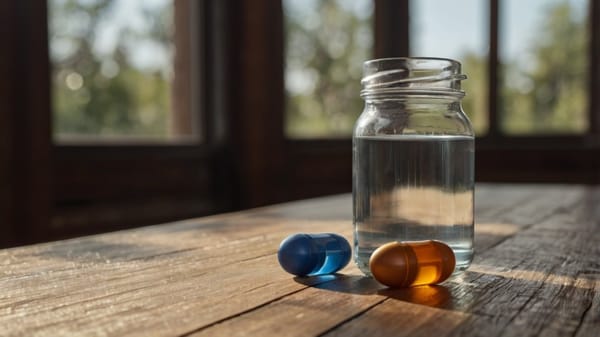Is BCAAs Worth the Hype? Here's What You Need to Know
BCAAs help you recover faster, preserve muscle, and boost energy. Here’s how to use them for real results—without the hype.

Ever wonder if that scoop of BCAAs is actually doing anything—or if it's just another overhyped fitness trend? If you’re serious about your health and fitness, the answer matters.
You want energy that lasts, muscles that recover, and strength that sticks. BCAAs promise all of it. But do they actually deliver results for your goals and routine? Let’s break it down so you can decide if they’re worth the sip.
What Are BCAAs, Exactly?
BCAAs—short for branched-chain amino acids—are three specific amino acids your body can't make on its own: leucine, isoleucine, and valine.
Unlike most amino acids that get processed in your liver, BCAAs go straight to your muscles. That makes them fast-acting and ideal for energy, endurance, and muscle repair.
That’s not just bro science. BCAAs are backed by decades of research showing they support:
- Faster recovery after exercise
- Preservation of lean muscle
- Reduced exercise-induced fatigue
- Improved endurance
Now here’s where it gets real: your body naturally starts losing muscle over time—a process called sarcopenia.
You’re not just losing strength, you’re also slowing your metabolism, risking poor balance, and draining energy faster. BCAAs help fight that process head-on.

Why BCAAs Matter More When You’re Active and Want to Preserve Muscle
When you’re younger, your body is more forgiving. You can skip protein here and there, bounce back from workouts faster, and build muscle easily. As time goes on? Not so much.
Here’s what changes:
- Muscle protein synthesis slows down — it takes more effort to build and maintain muscle.
- Recovery time increases — soreness lasts longer, workouts hit harder.
- Fatigue creeps in faster — especially if you’re training fasted or not fueling properly.
That’s where BCAAs come in.
Leucine (the MVP of the trio) acts as a trigger for muscle repair. It signals your body to start rebuilding muscle tissue—even if you're just doing moderate activity like walking, biking, or yoga.
Isoleucine and valine help reduce muscle breakdown and give your body an immediate energy source during movement. It’s like flipping a switch your body stopped flipping on its own.
BCAAs in Real Life: How They Fit Into Your Routine
You don’t need to be an elite athlete to use BCAAs. In fact, most active people benefit from BCAAs in these everyday scenarios:
- You work out in the morning without breakfast — sipping BCAAs gives your muscles fuel without breaking a fast.
- You do resistance training or long walks — BCAAs help reduce soreness and speed recovery.
- You’re inconsistent with protein intake — BCAAs are a quick, effective way to support muscle preservation on lighter protein days.
- You feel “wiped out” after workouts — BCAAs can help reduce that crash and get your energy back up faster.
And it’s not just about the workout. BCAAs help keep your energy steady during the day too—especially if you’re balancing work, family, and staying active.
When and How to Take BCAAs for Best Results
Timing: Take 5–10 grams of BCAAs before or during exercise for the biggest benefits. If you train fasted (no food before workouts), this is especially important.
If your workouts are light but frequent, even a 5g dose daily can help you feel more recovered and energized.
How to take it: Mix a scoop of flavored BCAA powder with cold water and sip it like you would a sports drink.
Most powders come uncarbonated, mildly sweet, and easy on the stomach. No need to choke down pills or prep anything complicated.
Pro tip: Use BCAAs as a pre-workout ritual. That small habit cue tells your body: “It’s time to move.”
Are You Wasting Your Time If You Already Get Protein?
Good question. If you're consistently eating high-quality protein at every meal—eggs, fish, chicken, plant-based protein—you may be getting enough BCAAs naturally. But that’s a big “if.”
A lot of people overestimate how much protein they’re getting. Miss a meal here, downsize a portion there—and suddenly your muscle recovery slows down. BCAAs give you targeted support without having to eat another chicken breast.
Also, BCAAs absorb faster than whole proteins. You feel them kick in sooner, which makes them ideal around workouts or on busy days when you need a quick boost.
What to Stack with BCAAs for Maximum Effect
Want to take it up a notch? These stacks work well with BCAAs:
- Creatine – Great for maintaining strength and power, especially if you’re doing any kind of lifting or resistance training. Pairs well with BCAAs for muscle support.
- Whey or Plant Protein – If you’re low on dietary protein, adding a post-workout shake with both protein and BCAAs covers all your recovery bases.
- Magnesium – Helps reduce cramps, supports sleep, and aids muscle relaxation—perfect for active recovery at night.
Keep your stack lean and clean. More isn’t always better—smarter is better.
BCAAs vs. EAAs: Do You Need the Full Set?
You might hear about EAAs (essential amino acids) being “better” than BCAAs. That depends on your goal.
EAAs include all nine essential aminos, which is great for overall protein synthesis—but BCAAs are still the key drivers for muscle-specific recovery and energy.
For most people focused on fitness, energy, and muscle preservation, BCAAs are more than enough.
Want both? Some advanced formulas include BCAAs plus the other essential aminos. But if you’re keeping it simple, BCAAs alone still deliver.
Final Thoughts: Are BCAAs Worth It?
Here’s the bottom line: If you’re active and want to protect your strength, boost your energy, and recover faster—BCAAs are 100% worth it.
They’re low-effort, fast-acting, and incredibly easy to work into your routine. No complicated timing, no meal prep, no fluff. Just mix, sip, and go.
Start now. Grab a clean BCAA powder, mix it up before your next walk, workout, or stretch session—and feel the difference. Better energy. Less soreness. More strength to keep showing up tomorrow.




